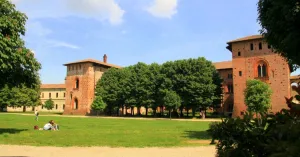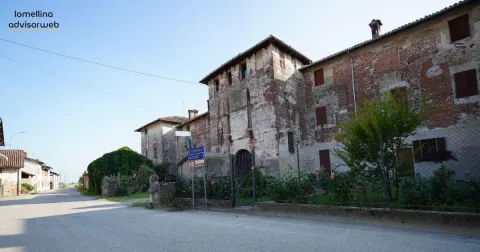La città di Vigevano è situata nella Lomellina nord-orientale a circa 35 km da Milano. Il nucleo più antico della città nacque nell’alto medioevo come borgo fortificato a difesa del guado sul Ticino. Divenne in seguito libero comune e venne conteso, per la sua posizione strategica, da Milano e Pavia in lotta tra loro. Successivamente passò sotto la signoria dei Della Torre, ma fu a partire dal XIV secolo, prima con i Visconti e. dalla metà del XV secolo, con gli Sforza, che Vigevano conobbe il suo massimo splendore artistico diventando città ducale, ricca di attività artigiane e commerciali e sede vescovile.
Il Castello sorge nella parte più alta della città e si innesta sull’assetto planimetrico e sulla struttura del preesistente castello-ricetto di età comunale.
La sua costruzione è caratterizzata da due fasi successive: una viscontea ed una sforzesca. La prima iniziò per volere di Luchino Visconti, podestà di Vigevano, che fece costruire la “Rocca Vecchia” nel 1341. Tale costruzione era stata ideata a guardia della strada per Milano. Nel 1345, Luchino Visconti realizzò il castello vero e proprio, il “Maschio”, a forma quadrilatera con quattro torri angolari e merlatura ghibellina. Due anni più tardi, i due fortilizi vennero collegati dalla “Strada Coperta”, una sorta di ponte fortificato (lunga 164 metri e larga 7 metri) che scavalca il borgo consentendo in tal modo una valida via di fuga dal castello alla campagna. La fase sforzesca, grazie al prezioso contributo artistico di Donato Bramante, conferì al castello i caratteri di grandiosa residenza nobile e lo splendore di una tra le più ricche corti rinascimentali d’Europa. Dal 1492 al 1494 il Duca Ludovico Maria Sforza, detto il Moro, fece completare la costruzione delle scuderie, già iniziata da Galeazzo Maria, e la “Falconiera” dove i falconi venivano allevati e addestrati per la caccia. Inoltre il “Maschio” venne completamente trasformato in zona residenziale, arricchito da lussuose sale decorate e da eleganti finestre. Nella parte posteriore del “Maschio” venne aggiunta un’ala residenziale riservata alla Duchessa Beatrice d’Este e la “Loggia delle Dame” affacciata sul giardino pensile, luogo preferito dalla duchessa per i propri svaghi.
La fine della dinastia sforzesca (1535) segnò l’inizio di un lento declino del castello che lo vide ospitare eserciti e caserme per più di tre secoli.
L’Associazione Vigevano Promotions organizza itinerari su misura di mezza o una giornata per accompagnare gruppi di visitatori alla scoperta delle storie e leggende in essi custodite.
Per informazioni sulle visite guidate:
tel: +39 351 8782734
e-mail: info@vigevanopromotions.it
Castello Visconteo Sforzesco - Vigevano
Edificato a partire dal XIV secolo, il Castello Sforzesco di Vigevano si affaccia con la Torre del Bramante sulla splendida Piazza Ducale.
Galleria Fotografica
Descrizione articolo
[Per segnalare eventuali refusi/errori usa la form di contatto. Grazie per la collaborazione.]
Luoghi di interesse
La pagina in cui ti trovi rappresenta un luogo di interesse appartenente ad un itinerario, clicca qui per vederlo completo
Prosegui la scoperta del territorio attraverso i nostri itinerari, clicca qui per vederli tutti
Prosegui la scoperta del territorio attraverso i nostri itinerari, clicca qui per vederli tutti
Luogo successivo dell'itinerario
Castello Beccaria Litta - Gambolò
Realizzato intorno al X secolo, il Castello di Gambolò subì numerosi rimaneggiamenti diventando, infine, villa di campagna sotto richiesta del Marchese Agostino Litta.
Mostra percorso
Luogo precedente dell'itinerario
Castello di Villanova - Cassolnovo
Il castello situato alla frazione Villanova, risalente al XIV secolo, fu residenza di campagna dei duchi Sforza che lì sperimentarono per la prima volta la coltivazione del riso in Lomellina.
Mostra percorso
Data di pubblicazione
22.09.2022




